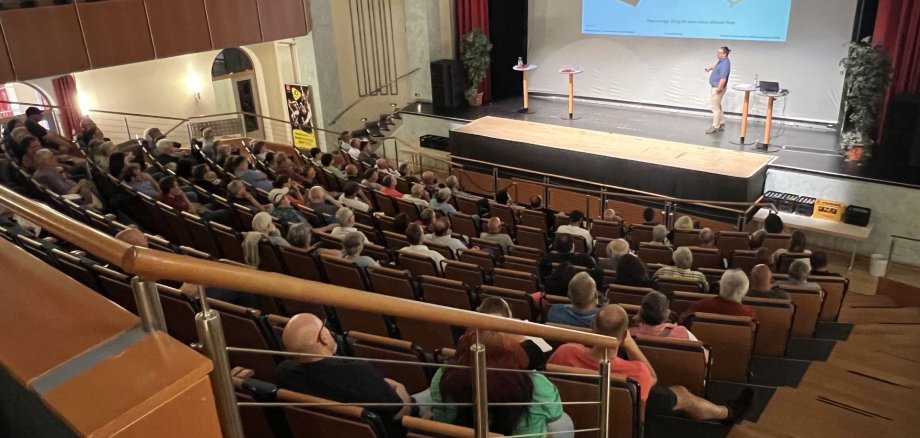Around 150 people were interested in the information event organized by ZENAPA and the city of Idar-Oberstein on the subject of "Solar offensive - saving coal with sunshine", which was moved to the municipal theater at short notice.
In his welcoming address, Mayor Friedrich Marx was delighted with the great response to the topic and briefly highlighted the municipal properties and open spaces on which PV systems have already been installed. The amount of solar power generated there amounts to around 1.249 MWh per year. Marx also made a brief reference to the municipal subsidy program, under which citizens of Idar-Oberstein can receive a grant for a new plug-in balcony PV system.
Before the first speaker, Steffi Erbach, the climate change manager for the Hunsrück-Hochwald National Park, briefly introduced herself. The IfaS (Institute for Applied Material Flow Management) of Trier University of Applied Sciences at the Birkenfeld Environmental Campus has been cooperating with the national park since 2016 to contribute to climate, nature and species protection.
Christoph Dohm from IfaS spoke about generating electricity on your own roof, explaining the differences in technology and the requirements for the location. His conclusion is that even if the orientation of the roof is not optimal in the direction of the sun, it is definitely better than no PV system at all. In addition to the roof of a house, there are many other ways to generate solar power, such as patio roofs, facades, fences or carport roofs. Dohm also discussed the tax assessment of a PV system.
Florian Schmidt, assessed the topic of solar power from the perspective of the grid operators Westnetz and OIE, who are facing different challenges than before due to the changed requirements such as charging e-cars and feeding private electricity into grids. Westnetz and OIE have been working on the smartification of the grid for some time, with 16 digital local grid stations already being put into operation in 2023 and 33 this year. For end consumers, the OIE offers an online portal where citizens or electricians can transmit the data for feeding a PV system into the grid. As far as the increasingly popular balcony PV systems are concerned, these must now be registered directly with the Federal Network Agency via the market master data register at www.marktstammdatenregister.de. The OIE then receives information from there that the meter needs to be replaced. One plug-in balcony PV system, also known as a balcony power plant, can be connected per electricity meter in the house.
Finally, Christoph Benkendorff informed the audience on behalf of the Rhineland-Palatinate consumer advice center specifically about balcony power plants, which consist of one or two PV modules, an inverter and a plug-in supply line as well as a connection line to the socket. The PV modules can have an output of up to 2 kWp (kilowatt peak), the inverter up to 800 VA (volt-ampere). He also discussed the costs, which can vary from 400 euros to 1000 euros, but also warned that the system must have CE certification. In addition, compliance with the DGS safety standard is recommended.
Many of those present were particularly interested in the city's subsidy for the balcony power plants, which is financed with funds from the state government from the "KIPKI - Municipal Investment Program for Climate Protection and Innovation" program. Funding is available for plug-in balcony PV systems consisting of one or two solar modules and an inverter with a maximum permissible inverter feed-in power of up to 800 watts and which complies with the relevant national and international standards. The system must be registered in the market master data register and professionally installed. The subsidy is only available in the Idar-Oberstein municipal area, only for one system per household, the useful life is five years and no EEG remuneration may be claimed for the balcony PV electricity generated. A one-off flat-rate subsidy can only be granted per household, namely €75 for a device with one solar module and inverter (250-600 or -800 watts) or €150 for a device with two solar modules and inverter (up to 600 or 800 watts). This subsidy can be combined with other subsidies. The sum of the combined subsidies may not exceed the total eligible purchase costs. There is no legal entitlement to the subsidy. The administration decides on the basis of its dutiful discretion and within the framework of the available budget funds. If the funding pot is exhausted, the program will be closed. Persons whose main place of residence is in the city area and for whose private household the system is to be purchased are eligible to apply.
It is of central importance that the application is submitted first and that the balcony PV system is only purchased once the subsidy notification has been received. The date of the purchase contract must not be before the date of the subsidy approval. A declaration of consent from the owner is required for rented apartments or houses, and approval must be obtained from the relevant monument protection authority for listed buildings. It is important to note that the order in which complete applications are received determines the order in which grants are awarded! After the grant notification has been issued, applicants have 6 months to purchase, install and commission their "plug-in balcony PV system" and submit the application for payment. The term of the funding program ends when the funds made available have been exhausted or the last possible date for submitting an application is 30 September 2025.
Further information on the funding program and the forms to be completed can be found at https://www.idar-oberstein.de/bauen-wohnen-wirtschaft/bauen-und-wohnen/klimaschutz/foerderprogramm-steckerfertige-balkon-pv-anlage/.
